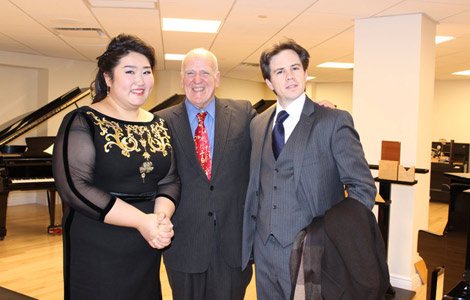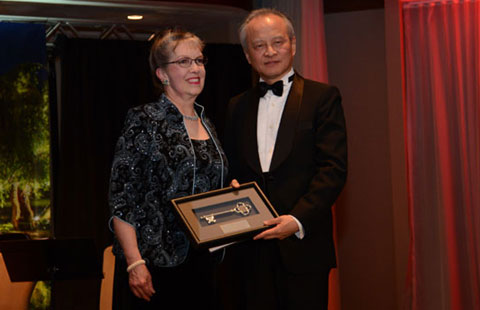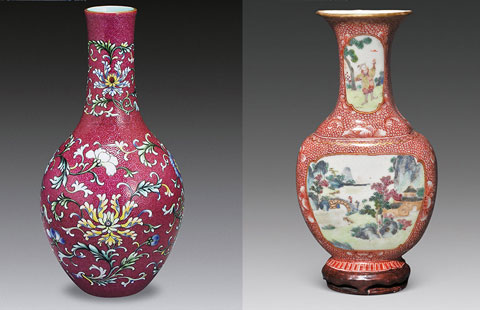|
||||||||
This small rural Virginia town was thrust into the spotlight last year when local Smithfield Foods - the world's largest pork processor and hog producer - was bought for $7.1 billion by Chinese company Shuanghui International.
Visitors entering the "Ham Capital of the World" should not be surprised to be greeted by eight colorfully painted and playful life-sized statues of hogs placed along the downtown streets, all created by local artists to reflect the town's culture and legacy.
Aside from bacon and sausage, there is a rich taste for art here too. Sharing the same building with the town's visitor center is an arts center, where several resident artists create and exhibit their work. Among them is Roy Williams, a retired chemistry professor, who dabbles in Chinese ink, one of the few things visitors will find relating to China in this small town.
At the Smithfield Little Theatre, near the Smithfield Foods headquarters, the town's musicians and visiting troupes from afar stage performances from time to time.
As a start to the trip, stopping by the Visitors' Center on the Main Street, grabbing a map and brochures and listening to the introduction by a guy with the first name of Collins is very helpful.
We actually toured the compound of Smithfield Foods headquarters along the Pagan River before heading to the visitors' center. Red brick office buildings, giant sculptures of the company's founders, the Luters, more porcine statues and a wooden boardwalk along the waterfront all make for a pleasant scene against the backdrop of the river and birds soaring and diving.
Founded in Smithfield in 1936 by Joseph W. Luter and his son, Smithfield Foods, a Fortune 500 company, now has 46,000 employees worldwide and revenues of $13 billion.
Yet the town is far more than a ham hamlet, it's also a historic town, as many town folks will tell you.

Dozens of well-preserved historic houses of different styles create a unique setting. Gothic cottages, colorful, eye-catching Victorian homes and stately Federalist dwellings are all worth exploring at a leisure stroll.
The small Isle of Wight Courthouse, built in the 1750s, has been restored to its original state. History seemed to come alive as Onycha Bias, the woman on duty that day, told stories of the place in the old days.
The Isle of Wight County Museum, which displays the rich history of Smithfield - agriculture, art, Southern hospitality, and, of course, ham - is also worth a visit.
Historic St. Luke's Church is said to be the oldest existing church of England founded in the United States and the country's only surviving original brick Gothic church featuring a Jacobean interior, 17th-century altar fittings and the world's oldest intact English chamber organ.
You don't want to miss the Taste of Smithfield caf and gourmet retailer, where locally made ham, other local food products and souvenirs are sold.
Lunch here is an absolute delight. Most sandwiches, burgers and salads feature the town's unique salt-cured ham, sliced paper-thin and especially tasty.
The Smithfield Inn, built in 1752, is another place to sample the local food where the dining setting is more refined compared to the casual Taste of Smithfield cafe.
It's said that George Washington once stayed here, which is probably why one room is named the George Washington Suite. The price for a suite is $150 or $175, depending on the day of the week.

 Music at her fingers
Music at her fingers
 Across America Over the Week (Jan 16 - Jan 22)
Across America Over the Week (Jan 16 - Jan 22)
 Spend Chinese New Year in style
Spend Chinese New Year in style
 Ili river valley becomes a popular destination for swans
Ili river valley becomes a popular destination for swans
 Philip Ma: from scientist to businessman
Philip Ma: from scientist to businessman
 Birmingham's Spotlight on China dinner
Birmingham's Spotlight on China dinner
 How to distinguish doucai, wucai, Famille-rose and enamel porcelain
How to distinguish doucai, wucai, Famille-rose and enamel porcelain
 Xinjiang lake in bumper fishing season
Xinjiang lake in bumper fishing season
Most Viewed
Editor's Picks

|

|

|

|

|

|
Today's Top News
Houston's SW Chinatown
China to focus on reforms, opening of capital market
Slowdown brings new risks to banks
Trade group calls for BIT
Market status for China is 'political' issue
Birmingham's Spotlight on China dinner
Bank takes renminbi-clearing seriously
Traditional Garb
US Weekly

|

|







